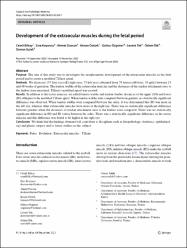Development of the extraocular muscles during the fetal period

Göster/
Erişim
info:eu-repo/semantics/embargoedAccessTarih
2023Yazar
Bilkay, CemilKoyuncu, Esra
Dursun, Ahmet
Öztürk, Kenan
Özgüner, Gülnur
Tök, Levent
Tök, Özlem
Sulak, Osman
Üst veri
Tüm öğe kaydını gösterKünye
Bilkay, C., Koyuncu, E., Dursun, A., Öztürk, K., Özgüner, G., Tök, L., ... & Sulak, O. (2023). Development of the extraocular muscles during the fetal period. Surgical and Radiologic Anatomy, 1-7.Özet
Purpose: The aim of this study was to investigate the morphometric development of the extraocular muscles in the fetal period and to create a modified Tillaux spiral.
Methods: We dissected 157 fetal eyes (82 right eyes, 75 left eyes) obtained from 79 fetuses (46 boys, 33 girls) between 13 and 40 weeks of gestation. The tendon widths of the extraocular muscles and the distances of the tendon attachment sites to the limbus were measured. Tillaux's modified spiral was created.
Results: In addition to the rectus muscles, we added tendon widths and tendon-limbus distances of the upper (SO) and lower (IO) obliques to the modified Tillaux spiral. When tendon widths were compared between genders, no statistically significant difference was observed. When tendon widths were compared between the sides, it was determined that SO was more in the left eye, whereas other extraocular muscles were more in the right eye. There was no statistically significant difference between genders when the distances of tendon attachment sites to the limbus were compared. There was no statistically significant difference in SO and IO values between the sides. There was a statistically significant difference in the rectus muscles and this difference was found to be higher in the right eye.
Conclusion: We think that the findings obtained will contribute to disciplines such as fetopathology, obstetrics, ophthalmology and plastic surgery and to future studies on this subject.















